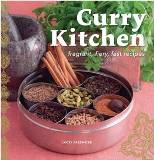The culinary heritage of India is so rich and diverse that it seems such a pity and even disrespectful just to lump it all together and call it “curry”.
We are not helped by the urban curry house which on occasion reduces it to “which type of pre-cooked meat do you want us to heat in which of the three or four industrial sauces we have on the go and how much chilli do you want us to put in it?”, offered in the guise of a choice of westernised favourites. All right, they might be trying to turn out a lunch for about $10 but even so… Happily there are some that make the effort although at one I visited recently, the owner actually felt he should apologise for a minimally longer wait as the chef preferred to prepare each dish himself. (It was Temptation in Newtown for any Wellingtonians… the lunch was excellent and $14)
And then there is vindaloo…
When the Portuguese colonised parts of India in the fifteenth and sixteenth centuries they introduced many new foods, among them one that changed Indian food forever, the chilli pepper. In the creative hands of their Goan cooks and with addition of native spices and the new chilli peppers, a popular Portuguese pork stew seasoned with garlic and vinegar, called carne de vinho e alho, evolved into today’s vindaloo (or vindalho).
It is a spicy, fragrant dish, intended to give pleasure and certainly not, as it is in Britain and increasingly here, to be a macho rite of passage. In fact vindaloo is no longer hot enough for some “blokes” so Indian restaurateurs in Britain created the phal, a dish so chilli-hot as to be painful. Why one should eat unenjoyably spicy food to know if one is Aabha or Madhur is beyond me. Maybe the fact that these dishes are mostly sold after pub closing time is an indication.

Anyway, here is the vindaloo recipe I use and if you want others or recipes for more curries, my cookbook of the week is:
Curry Kitchen by Jacki Passmore
Published by Penguin RRP $37.00
Pork Vindaloo
700g (approx.) lean shoulder pork (boned weight)
MARINADE
- 1 tsp cumin seeds
- 1 tsp black mustard seeds
- 6-8 large cloves of garlic
- 2 fresh red chilli peppers (stems removed)
- I medium onion
- 6cm piece peeled fresh ginger
- 2 Tbsp wine vinegar (cider vinegar will do)
- 2 Tbsp vegetable oil
- ½ tsp ground cinnamon
- ¼ tsp ground cloves
Cut the pork into 3cm pieces. Set aside.
Dry roast the cumin and mustard seeds in small frying pan over medium heat until the cumin darkens and the mustard turns grey (about 4 minutes). When cool, grind to fine powder. Set aside.
Put onion, chilli peppers, garlic, ginger, vinegar and oil into food processor and blitz until it becomes a smooth paste then mix in the cumin/mustard seed mixture, cinnamon and cloves. Pour this paste over the pork and mix well. Leave to marinate for a minimum of 8 hours or refrigerate for 48 hours.
COOKING
- ½ cup vegetable oil
- 2 medium onions
- 1½ tsp turmeric
- 1½ tsp ground cayenne pepper (adjust to taste)
- 1½ tsp paprika
- 2 tsp sea salt
- 2 tsp tamarind purée (available in supermarkets)
- 1½ cups water
- Any marinade remaining
Thinly slice the onions.
Heat oil in large pan over medium-high heat, add onions and cook until they turn caramel brown (about 12 – 15 minutes) stirring to make sure they do not burn.
Reduce heat to medium; add turmeric, cayenne and paprika. After 15 seconds add the meat and fry for about 10 minutes, stirring occasionally.
Add salt, tamarind, water and any marinade left from pork. Stir and bring to a boil. Lower heat and cook, partially covered until meat is cooked and tender (30 – 45 minutes). If the dish is too wet after this time or if you wish a thicker sauce or drier curry, remove the cover and allow the liquid to reduce over a medium heat for a while
Check for salt and serve with Basmati rice and raita.
It improves with keeping and can be refrigerated for about 4 days or frozen.
Serves 4










Join the Discussion
Type out your comment here:
You must be logged in to post a comment.